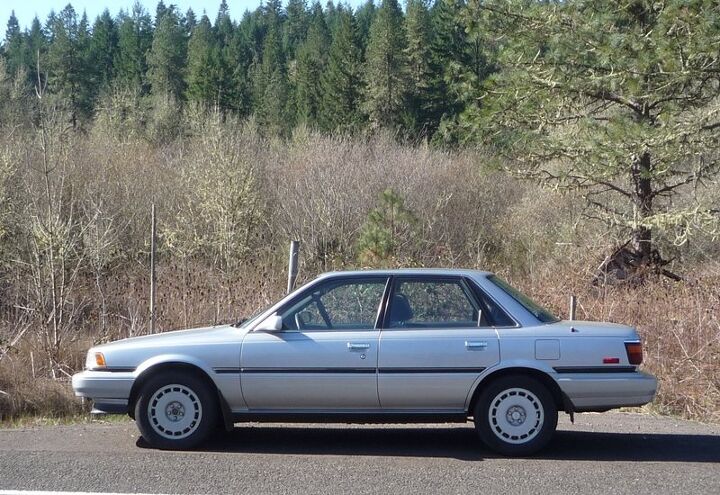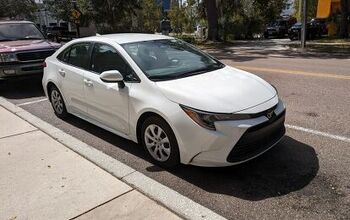Curbside Classic Review: 1990 Toyota Camry LE V6

TTAC’s Steve Lang recently documented the historical “leaning” of the Camry beginning with the 1997 model here, and EN’s recent editorial on the transition from “fat” to “lean” quality standards documented Toyota’s rationale and its consequences. So when a neighbor asked me if I wanted to check out and drive a used 1990 Camry she was buying, I figured it was an opportunity to indulge in some genuine Toyota fatness. Little did I realize I was about to have the automotive equivalent of a banana split.
I had suggested she look at for an older Camry after her Volvo 850 munched its valves due to a broken timing belt. She now understands why they’re supposed to be changed. And what did she find? A pristine one-owner 1990 LE V6 with 79k miles that had been driven by a preacher. How’s that for a cup of fresh Devonshire cream?
In my l ast last review of an older Camry, I pitted a gen3 1993 Camry V6 against a 2008 Charger V6. I’ll let you guess who won. Before you think I go out of my way to drive old Camrys, that was a rental in Hawaii, a beater with over 200k miles on the clock. It acquitted itself quite well, none the less.
This Camry looks almost new. It simply exudes solidity from every extrusion, piece of trim, and its paint. OK; it obviously wasn’t abused in its twenty years with the preacher. But the years do tend to take their toll. As do the damn motorized retractable seat belts, the scourge of all cars of this vintage. I’d almost forgotten about them; despicable.
This Camry may be fat in content, but its size is anything but. In a classic example of inflation, the 2010 Corolla is bigger than this Camry in every way: 2.4″ longer wheelbase, 2.3″ more width, 3.6″ taller, an inch longer overall, and it would weigh more if this wasn’t a V6 version. The gen 2 Camry was the last one still made within Japan’s width=tax limits, and it shows, or doesn’t. It took a minute or two to for my tallness to feel properly accommodated. But that happens with just about any car, thanks to being spoiled by my xB. That’s why I put up with its harsh ride: a profound lack of cranial restriction.
The four-cam 24 valve 2.5 liter V6 purrs to life, and we head for the country on this sunny day. This is a very short stroke and small displacement six, so fatness in its torque band is not part of the equation. One has to poke a bit on that non-e pedal to get some life out of it. But it’s happy to spin, and is about as smooth and creamy as anything made today. With 156 horses, it’s willing to move the 2800 Camry right along, but you have to ask firmly. And the four-speed automatic shifts as silky-smooth as it did two decades ago, and feels every bit as competent as the four speed still being used in the 2010 Corolla.
Speaking of Toyota gas pedals, I came across this heads up from the NTHSA file on Camrys:
Throttle linkage (1987, 1988, 1989, 1990): Various complaints filed with NHTSA suggest some vehicles may have a “sticky” linkage between the accelerator pedal and the engine’s throttle mechanism; some owners reported “sudden acceleration” if the pedal did not immediately return to idle position on being released.
On further investigation, it turns out this was a problem with sticking throttle valves, due to carbon build-up. More often, the pedals wouldn’t go down so much as not come back up, but it does point out that throttle issues are far from new.
Once you get past the almost forgotten seat belt routine (I forgot to buckle the lap belt), the one really glaring time-warp is the steering. The wheel is big, the rim is hard and skinny, and the assist is remarkably low. Compared to the synthetic overboosted electric steering on the new Toyotas, this feels just like a big Mercedes tiller of yore. Heavy, rather dull, and a remarkably strong self-centering action. This Camry constantly screams at you that it prefers not to change directions, ever.
Well, no one ever accused a Camry of sporting pretensions. The ride on its undoubtedly original shocks is still pretty decent; as long as one stays away from curves with any kind of speed. But the really predominant sensation is the utter solidity of this car’s body and interior. After twenty years, there is not one minute creak, rattle, or groan anywhere to be heard or felt. Except for the slightly enfeebled (or were they like this new?) shocks, it feels like it’s being driven off the dealer’s lot. Tight, solid, carved from a granite block, bank-vault like; what other over-used metaphors should I employ?
And for what cars were those metaphors typically used back in the day? Mercedes. This Camry is the closest thing I’ve ever driven that mimics the sensations of an old W124 Benz. The structural solidity, the low-torque high-rpm six that has to have the spurs put to it, the heavy and dull steering (the W 124’s Achilles heel), the high-quality interior materials. Obviously, the Camry can’t touch the Mercedes in terms of the interior design and tactile feel (and room), but everything is genuine quality padded vinyl or cloth. Nary a hard surface to be seen, except that highly unpleasant steering wheel, which the early W124s also had.
Yes, this Camry is the classic old school Japanese “imitation” of an old-school Mercedes. They both espoused pure unadulterated quality as the key to success. And then they both threw it away, at about the same time. But for $3500, my neighbor just bought a high-calorie virtual time capsule from 1990, and I suspect she may have it for a while. Just don’t forget to change that timing belt!

More by Paul Niedermeyer
Latest Car Reviews
Read moreLatest Product Reviews
Read moreRecent Comments
- Jeff Self driving cars are not ready for prime time.
- Lichtronamo Watch as the non-us based automakers shift more production to Mexico in the future.
- 28-Cars-Later " Electrek recently dug around in Tesla’s online parts catalog and found that the windshield costs a whopping $1,900 to replace.To be fair, that’s around what a Mercedes S-Class or Rivian windshield costs, but the Tesla’s glass is unique because of its shape. It’s also worth noting that most insurance plans have glass replacement options that can make the repair a low- or zero-cost issue. "Now I understand why my insurance is so high despite no claims for years and about 7,500 annual miles between three cars.
- AMcA My theory is that that when the Big 3 gave away the store to the UAW in the last contract, there was a side deal in which the UAW promised to go after the non-organized transplant plants. Even the UAW understands that if the wage differential gets too high it's gonna kill the golden goose.
- MKizzy Why else does range matter? Because in the EV advocate's dream scenario of a post-ICE future, the average multi-car household will find itself with more EVs in their garages and driveways than places to plug them in or the capacity to charge then all at once without significant electrical upgrades. Unless each vehicle has enough range to allow for multiple days without plugging in, fighting over charging access in multi-EV households will be right up there with finances for causes of domestic strife.








































Comments
Join the conversation
All of this recall hysteria brings to mind an important question: Which vehicles today are truly well-made, and are any of them affordable? I don't see many late-model used vehicles that are still tight and rattle-free after 30,000 miles of service. Granted, it was probably rough, rental car service we're talking about, but still...
Great editorial. I had one of these. I had broken my left leg and was going to have to go clutchless for a while, so I found one of these. The only issue was that someone had bolted a luggage rack to the trunk, and the area around the bolts was rusting. Otherwise, it was solid and well-mannered; in fact, too much so for me. My parents told me they had put up their '90 Accord for sale, and I immediately bought it, since I found driving it far more fun.